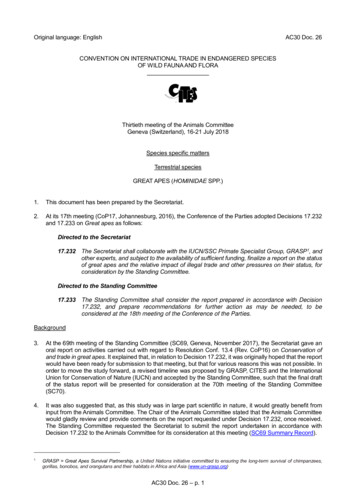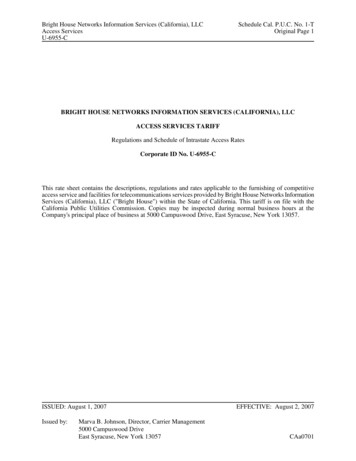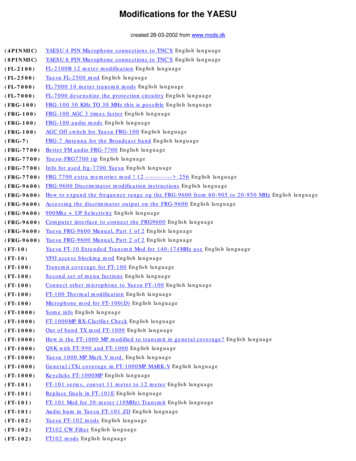
Transcription
Original language: EnglishAC30 Doc. 26CONVENTION ON INTERNATIONAL TRADE IN ENDANGERED SPECIESOF WILD FAUNA AND FLORAThirtieth meeting of the Animals CommitteeGeneva (Switzerland), 16-21 July 2018Species specific mattersTerrestrial speciesGREAT APES (HOMINIDAE SPP.)1.This document has been prepared by the Secretariat.2.At its 17th meeting (CoP17, Johannesburg, 2016), the Conference of the Parties adopted Decisions 17.232and 17.233 on Great apes as follows:Directed to the Secretariat17.232 The Secretariat shall collaborate with the IUCN/SSC Primate Specialist Group, GRASP1, andother experts, and subject to the availability of sufficient funding, finalize a report on the statusof great apes and the relative impact of illegal trade and other pressures on their status, forconsideration by the Standing Committee.Directed to the Standing Committee17.233 The Standing Committee shall consider the report prepared in accordance with Decision17.232, and prepare recommendations for further action as may be needed, to beconsidered at the 18th meeting of the Conference of the Parties.Background3.At the 69th meeting of the Standing Committee (SC69, Geneva, November 2017), the Secretariat gave anoral report on activities carried out with regard to Resolution Conf. 13.4 (Rev. CoP16) on Conservation ofand trade in great apes. It explained that, in relation to Decision 17.232, it was originally hoped that the reportwould have been ready for submission to that meeting, but that for various reasons this was not possible. Inorder to move the study forward, a revised timeline was proposed by GRASP, CITES and the InternationalUnion for Conservation of Nature (IUCN) and accepted by the Standing Committee, such that the final draftof the status report will be presented for consideration at the 70th meeting of the Standing Committee(SC70).4.It was also suggested that, as this study was in large part scientific in nature, it would greatly benefit frominput from the Animals Committee. The Chair of the Animals Committee stated that the Animals Committeewould gladly review and provide comments on the report requested under Decision 17.232, once received.The Standing Committee requested the Secretariat to submit the report undertaken in accordance withDecision 17.232 to the Animals Committee for its consideration at this meeting (SC69 Summary Record).1GRASP Great Apes Survival Partnership, a United Nations initiative committed to ensuring the long-term survival of chimpanzees,gorillas, bonobos, and orangutans and their habitats in Africa and Asia (www.un-grasp.org)AC30 Doc. 26 – p. 1
5.The Standing Committee established an intersessional working group on great apes with a mandate toreview the report undertaken by the Secretariat in accordance with Decision 17.232 and anyrecommendations coming from the Animals Committee, and report to the 70th meeting of the StandingCommittee with any draft recommendations. The membership was determined as follows: Canada (Chair),China, European Union, France, Indonesia, Malaysia, Nigeria, Thailand, United Kingdom of Great Britainand Northern Ireland, and the United States of America; and Born Free Foundation, Convention on MigratorySpecies, Food and Agriculture Organization, International Union for Conservation of Nature, TRAFFIC,Wildlife Conservation Society, Wildlife Impact, and the World Association of Zoos and Aquariums.6.A draft report has been prepared by the GRASP Secretariat in collaboration with a number of expertsincluding those from the Primate Specialist Group of the Species Survival Commission (SSC) of IUCN andit is presented in the Annex to the present document. This draft has been reviewed by the GRASP ScientificCommission and the IUCN Primate Specialist Group/Section on great apes. The Animals Committee isinvited to review and provide comments and any recommendations it might have on the draft report.7.A revised and final report will be prepared for SC70, taking into consideration the comments from the AnimalsCommittee and the Standing Committee’s intersessional working group on great apes.Recommendation8.The Animals Committee is invited to review the report in the Annex and provide comments, feedback andrecommendations, as appropriate, to the Secretariat, for it to bring to the attention of the authors before theyfinalize the report and submit it to the Standing Committee.9.The Animals Committee may wish to consider establishing an in-session working group to carry out thisreview at this meeting.AC30 Doc. 26 – p. 2
AC30 Doc. 26Annex(English only / seulement en anglais / únicamente en inglés)Great Apes Status ReportEditors: J. Refisch1 and S. A. Wich2Population data analysis, compilation and maps: Tenekwetche Sop, IUCN SSC A.P.E.S. databasemanager3With contributions and reviews by (in alphabetical order): Marc Ancrenaz 4, Rich Bergl5, Tanya Humle6,Rebecca Kormos7, Hjalmar Kühl3, Liz Macfie8, Fiona Maisels9, 10, John Oates11, Martha Robbins3, JulieSherman12, Liz Williamson101Great Apes Survival Partnership, United Nations Environment Programme, P.O. Box 30552, 00100 Nairobi,Kenya2John Moores University Liverpool, School of Natural Sciences and Psychology, Liverpool L3 5UA, UK3Max Planck Institute for Evolutionary Anthropology, Deutscher Platz 6, 04103 Leipzig, Germany4HUTAN – Kinabatangan Orangutan Conservation Programme, P.O. Box 17793-88874, Kota Kinabalu,Malaysia5North Carolina Zoo, 4401 Zoo Parkway, Asheboro, North Carolina, USA6Durrell Institute of Conservation and Ecology (DICE), School of Anthropology and Conservation, Universityof Kent, Canterbury CT2 7NR, UK7Department of Integrative Biology, University of California, Berkeley, California, USA8IUCN SSC Primate Specialist Group Section on Great Apes, Bankend, Duns TD11 3TY Scotland, UK9Wildlife Conservation Society, Global Conservation Program, 2300 Southern Boulevard, Bronx, New York, NY10460, USA10Faculty of Natural Sciences, University of Stirling, Stirling, FK9 4LA, UK11Department of Anthropology, Hunter College, 695 Park Avenue, New York, NY 10065, USA12Wildlife Impact, P.O. Box 31062, Portland, OR 97231, USAReport to the CITES Standing Committee on the Status of Great Apes1. IntroductionThe 65th meeting of the Standing Committee of the Convention of International Trade in Endangered Species ofWild Fauna and Flora (CITES) mandated the CITES Secretariat (SC65, Doc37) to collaborate with the IUCNSSC Primate Specialist Group, the Great Apes Survival Partnership (GRASP) and other experts, to prepare areport on the status of great apes and the relative impact of illegal trade and other pressures on their status, forconsideration by the Standing Committee. This report constitutes fulfilment of the mandate received from theCITES Secretariat and will address distribution and abundance trends related to all great ape species and subspecies, as well as threats to their conservation.All great ape species (chimpanzee, eastern gorilla, western gorilla, bonobo, Bornean orangutan, Sumatranorangutan and Tapanuli orangutan) face significant conservation threats and are listed as either Endangered orCritically Endangered by the IUCN Red List of Threatened Species (IUCN, 2017) and in Appendix I of CITES(CITES, 2017). Great ape populations in Africa and Asia are threatened by the combined impacts of habitat loss,poaching, disease and illegal trade. It is illegal to kill or capture great apes and to trade live animals or their bodyparts in all great ape range states (IUCN, 2017). However, despite legal protection, law enforcement remains amajor challenge in many countries, and poaching, especially the illegal domestic (and some international, albeitmostly regional, between neighbouring countries) trade in bushmeat, is the most significant threat to the survivalof most great apes.This report examines the current distribution of African and Asian great apes, as well as the temporal populationtrends (changes over time) and the main threats to their survival. It also highlights current conservation challengesand provides a list of recommendations to the CITES parties and the CITES Secretariat.1
2. African great apes2. 1. Current distribution of African great apesAfrican great apes occur in 21 countries across Equatorial Africa (Figure 1). There are four species and nine taxaoverall (Table 1).Table 1: The African great apesGenusGorilla2 speciesPan2 speciesSpecieseastern gorillaGorilla beringei2 subspecieswestern gorillaGorilla gorilla2 subspecieschimpanzeePan troglodytes4 subspeciesbonoboPan paniscusSubspeciesGrauer’s gorillaGorilla beringei grauerimountain gorillaGorilla beringei beringeiCross River gorillaGorilla gorilla diehliwestern lowland gorillaGorilla gorilla gorillacentral chimpanzeePan troglodytes troglodyteseastern chimpanzeePan troglodytes schweinfurthiiNigeria-Cameroon chimpanzeePan troglodytes elliotiwestern chimpanzeePan troglodytes verusNo subspecies currently recognized2
Figure 1: Geographic distribution of African great ape taxa and sites (IUCN SSC A.P.E.S. database, 20172), MaxPlanck Institute for Evolutionary Anthropology.2.2. African great ape population sizesThe African great ape population estimates in this report are based on surveys conducted in the past 10 years.“Site” in this text refers to any area in which surveys were conducted in the last 10 years, including amongst othersprotected areas and their buffer zones, a logging concession or a group of concessions. Population estimatespresented in this report are drawn from peer-reviewed publications, published or unpublished reports, data fromresearch and conservation organizations, or are expert estimates. Estimating population size is complex, becausegreat apes are difficult to observe. All great apes build a new nest to sleep in every night, and these can be usedas proxies for independent nest-building animals. A software package (Distance) incorporates animal signproduction (in this case night nests) and decay rate to calculate the density of animal sign and of population(Thomas, et al., 2010). Because sample size can be small where ape density is low, the resulting estimates ofabundance often show a great deal of variation in precision (see Kühl, et al., 2008). At some sites, geneticcensusing is used (Arandjelovic, et al., 2010; Arandjelovic, et al., 2011; Gray, et al., 2013; Roy, et al., 2014). Anoverview of survey methods can be found in Kühl, et al. (2008).2.2.1. Population size estimates per countryThere is great disparity in population estimates from taxon to taxon depending on the survey method used andsampling effort. Chimpanzee, gorilla and bonobo population estimates per range state are presented in Table 2.The Democratic Republic of Congo (DR Congo) and the Republic of Congo (Congo) host the highest combinedpopulation sizes of great apes in Africa, followed by Cameroon, Guinea and Gabon. Countries with the lowestgreat ape population numbers include Burundi, Ghana, Rwanda, Mali and Senegal, which each hosts a fewhundred great apes (Table 2).Table 2: African great ape population estimates by country. Except for mountain gorillas, estimates are based onthe number of “nest builders”, thus excluding infants. Estimates are derived from both surveys and modellingapproaches. This is the best information available. However, survey effort is often highest in protected areas,while other areas remain unsampled, thus can lead to low country estimates.CountryAngolaTaxonwestern lowlandgorillacentral chimpanzeeBurundiCameroonCentral AfricanRepublicCôte 4,801)SurveyperiodSource2005-2013Strindberg, et al. (2018)*2005-2013Strindberg, et al. (2018)Hakizimana & Huynen(2013)eastern chimpanzee204 (122-339)2011-2013Cross River gorilla132-1942014western al meroonchimpanzee3,000-7,0602004-2006western lowlandgorilla5529(3,635-8,581)2015N’Goran, et al. (2016)central chimpanzee2,843(1,194–4,855)2015Strindberg, et al. (2018)eastern chimpanzee910 (538-1,534)2012-2016Aebischer, et al. (2017)western chimpanzee580 (332-940)2007-2015Tiédoué, et al. (2016); IUCNSSC A.P.E.S. database(2017)2Ape Populations, Environments and Surveys databaseDunn, et al. (2014)Strindberg, et al. (2018)*IUCN SSC A.P.E.S. database(2017); Strindberg, et al.(2018)Morgan, et al. (2011);Mitchell, et al. (2015);Oates, et al. (2016)(http://apesportal.eva.mpg.de/).3
DemocraticRepublic of CongoGrauer's gorilla3,8002011-2015mountain gorilla2002010Gray, et al. (2013)central chimpanzeePresent(population sizeunknown)N/AInogwabini, et al. (2007)eastern chimpanzee173,000-248,0002010Plumptre, et al. (2010)2012IUCN & ICCN (2012)bonoboEquatorial Guineawestern lowlandgorillacentral chimpanzeeGabonwestern lowlandgorillacentral 9-60,476)2005-2013Strindberg, et al. (2018)*2005-20132005 2013Strindberg, et al. (2018)*Danquah, et al. (2012)Ghanawestern chimpanzee2642009Guineawestern chimpanzee21,210(10,007-43,534)2009-2014Guinea Bissauwestern chimpanzee1,000-1,5002016Liberiawestern chimpanzeeMaliwestern chimpanzeeCross River gorillaNigeriaRepublic of CongoNigeria-Cameroonchimpanzeewestern lowlandgorillacentral chimpanzee7,008 (4,26011,590)Present,(population 55,397(42,433-64,824)Plumptre, et al. (2016a)2011-2012201420142005WCF (2012; 2014)Kühl, et al. (2017)Chimbo Foundation (2017)unpublished dataTweh, et al. (2015)PANAF (2014) unpublisheddataDunn, et al. (2014)Morgan, et al. (2011); Oates,et al. (2016) ; Nixon &Maisels, pers. comm.2005-2013Strindberg, et al. (2018)*2005-2013mountain gorilla2302010eastern chimpanzee4302009-2014Sierra Leonewestern chimpanzee5,580(3,052-10,446)2009Senegalwestern chimpanzee500-6002016-2017South Sudaneastern chimpanzeePresent2011Pruetz and Wesslingunpublished dataPlumptre, et al. (2016b)Tanzaniaeastern chimpanzee2,5002010-2012Plumptre, et al. (2016b)430 (398-487)2010-2011Gray, et al. (2013); Roy, etal. (2014)5,0002006-2017Plumptre, et al. (2016b)Rwandamountain gorillaUgandaeastern chimpanzeeGray, et al. (2013)IUCN SSC A.P.E.S. database(2017)Brncic, et al. (2010)*All estimates from Strindberg, et al. (2018) are for 2013; western lowland gorilla populations are still decliningand will have lost a further 13% overall by 2018 from the 2013 estimate.4
2.2.2 Population size estimates per taxonWestern lowland gorillas and eastern chimpanzees are the most numerous great ape taxa, while the Cross Rivergorilla has the smallest population size, with fewer than 250 mature individuals remaining.Table 3: African great ape population estimates by taxon in descending order of abundance. Except for mountaingorillas, estimates are based on the number of “nest builders”, thus excluding infants. Estimates are derived fromboth surveys and modelling approaches. The IUCN Red List classification of most great ape taxa is based on therate of decline over three generations (one generation time equating to 20-25 years, depending on the taxon).Taxonwestern lowland gorillaGorilla gorilla gorillaeastern chimpanzeePan t. N dangeredPlumptre, et al. (2010; 2016b)central chimpanzeePan t. dberg, et al. (2018)Strindberg, et al. (2018)*CriticallyHumle, et al. (2016); Kühl, et al.western chimpanzee18,000-65,000Pan t. IUCN & ICCN (2012)Pan paniscusNigeria-CameroonMorgan, et al. (2011); Oates, et al.4,400-9,345Endangeredchimpanzee(2016)Pan t. ellioti3,800 (1,280CriticallyGrauer’s gorillaPlumptre, et al. (2015; 2016b)Gorilla b. graueri9,050)EndangeredCriticallymountain gorilla880Gray, et al. (2013); Roy, et al. (2014)Gorilla b. beringeiEndangeredCriticallyDunn, et al. (2014); Bergl, et al.Cross River gorilla 250Gorilla g. diehliEndangered(2016)* This was the estimate for the end of 2013. If the 2.7% decline has continued (highly likely), the population bythe end of 2018 will be around 316,000.2.3. Temporal trends in African great ape populationsWith the exception of the mountain gorillas, all African great ape taxa are facing an overall decline, some of themdrastically. The extent of the decline, however, differs between taxa, with Grauer’s gorillas suffering the highestestimated losses over a short period of time (Table 4)3.Grauer’s gorilla, Gorilla beringei graueriIn 1995, the Grauer’s gorilla population was estimated at 16,900 (Hall, et al., 1998). By 2015, however, estimatesplaced their population at only 3,800 individuls, with an annual rate of decline of 7.4%. This represents a declineestimated at between 84-93% across the subspecies’ range. Comparing the 1994 data to that of 2011-2015,researchers found a 77% reduction in density data. The subspecies is classified as Critically Endangered. Source:Plumptre, et al. (2015; 2016a).Mountain gorilla, Gorilla beringei beringeiWhilst the mountain gorilla is the only great ape taxon increasing in numbers, it remains Critically Endangeredwith an estimate of 880 individuals in the early 2010s. There are two small and isolated populations, the Virungaand the Bwindi populations, both of which have been the subject of intense conservation, research and censusefforts over the last 40 years (e.g. Robbins, et al., 2011). Numbers in the Virungas had dwindled to an estimated250 individuals by 1981, before the population then almost doubled between 1989 and 2010. Since 2003, thepopulation has increased by 26% at an annual rate of 3.7% (Gray, et al., 2013)4.Cross River gorilla, Gorilla gorilla diehliCross River gorilla population changes are unknown. The subspecies is classified as Critically Endangeredbecause of a small and highly fragmented population: each subpopulation is likely to number fewer than 50 matureindividuals. Source: Bergl, et al. (2016).3Some of the text in sections 2.3 and 3.3 is taken from the IUCN Red List assessments, as indicated by “Source”.4Updated census results expected in 2018.5
Western lowland gorilla, Gorilla gorilla gorillaThe Critically Endangered western lowland gorilla population declined by 19.4% between 2005 and 2013, anannual loss of approximately 2.7% (Strindberg, et al., 2018). Although their geographic range is large, they arethreatened by bushmeat poaching, disease (including Ebola), and habitat loss and degradation.Central chimpanzee, Pan troglodytes troglodytesThis subspecies is classified as Endangered, having experienced a significant population reduction since the1970s. The principal threats to this taxon, as for western lowland gorillas, are poaching for meat, disease, andhabitat loss and degradation. An analysis of nest survey data collected between 2003 and 2013 across the entirerange of the taxon did not detect a statistically significant decline (Strindberg, et al., 2018). Unlike gorillas, wherethe male will defend his family from a hunter and thus puts himself and the group in harms’ way, chimpanzeesslip away stealthily, and escape being killed. However, all the factors known to reduce chimpanzee populations(lack of forest guards, remoteness from roads, human population density, degree of forest intactness, etc.) werefound to be significantly correlated with population density in the direction predicted (Strindberg, et al., 2018).All of these factors are increasing in either extent or intensity, or both, so we predict that, as the longitudinaldataset increases, a decline will be statistically easier to detect.Eastern chimpanzee, Pan troglodytes schweinfurthiiThe Albertine Rift escarpment in DR Congo is a stronghold for eastern chimpanzees, but recent surveys indicate80-98% declines at some key sites in just 20 years, contributing to the major population declines seen in recentdecades. It is estimated that the populations in eastern DR Congo declined (range of estimated decline 22-45%)between 1994 and 2015. Eastern chimpanzees are listed as Endangered. Source: Plumptre, et al. (2016b).Nigeria-Cameroon chimpanzee, Pan troglodytes elliotiThis taxon has the lowest estimated population size of any chimpanzee subspecies. Its range is limited to clearlydefined areas in southern Nigeria and central-southwest Cameroon. Its Endangered listing is based on an inferredpopulation size reduction of between 50-80% over a three-generation period from the mid-1980s to 2060. Source:Oates, et al. (2016). Past presence of chimpanzees in Benin and Togo has been very poorly documented, but ifchimpanzees were in those countries, it is most probable that they were this subspecies (Ginn, et al., 2013).Western chimpanzee, Pan troglodytes verusThis subspecies, Pan troglodytes verus, has recently been upgraded to Critically Endangered as it is expected toexperience a decline exceeding 80% over the next 69 years, i.e. three generations (Humle et al., 2016). It is foundin West Africa from Senegal to Ghana but has almost certainly become extinct in Burkina Faso in the 20 th century(Ginn, et al., 2013; Campbell & Houngbedji, 2015). With a likelihood of probably more than 18,850 individuals,Guinea now hosts the largest remaining western chimpanzee population. Liberia and Sierra Leone are alsostrongholds for this subspecies (Kühl, et al., 2017). Approximately 17,000 individuals (half of the total westernchimpanzee population) live in the region of Fouta Djallon (Regnaut & Boesch, 2012). Between 1990 and 2015,the Côte d’Ivoire population declined by 80% (Kühl, et al., 2017); only a few hundred individuals remain in theTaï and Comoé National Parks (Campbell, et al., 2008). Between 2008 and 2011, the population in the Lagoas deCufadas National Park (Guinea-Bissau) declined by more than 60% (Carvalho, et al., 2013).Bonobo, Pan paniscusEndemic to the DR Congo, the Pan paniscus population is estimated to have declined sharply in the last 15-20years. This decline is projected to be over 50% over a 75-year period from 2003 to 2078. The species is listed asEndangered. Source: Fruth, et al. (2016).6
Table 4: African great ape population trends by taxon in descending order of abundance. Except for mountaingorillas, estimates are based on the number of “nest builders”, thus excluding infants. Estimates are based onboth surveys and modelled -9,345Grauer’sgorilla3,800 (1,2809,050)mountaingorilla880 Declining Declining Declining Declining Increasing DecliningAnnual rateof changeTotalestimatedchangePeriodassessedSource of trend-2.7%-19.4%20052013Strindberg, et al.(2018)-5.1%-22-45%**19942014Plumptre, et al.(2015; 2016b) -4.95% -50%20052013Maisels, et al.(2016b)-6.43%-80%-5.95%***-54.9%-1%**** -50%-0.92%2.14%-50-80%19852060-7.4%-94.2%19942015 3.7% 26%*****20032010199020152003201520032078Kühl, et al. (2017)Fruth, et al. (2016)Oates, et al. (2016)Plumptre, et al.(2015; 2016a;2016c)Gray, et al. (2013);Roy, et al. (2014)Cross River 250N.A.N.A.N.A.Dunn, et al. (2014)gorilla *Surveys conducted in 2003-2013 in western equatorial Africa were used to estimate total population size.**The 22% to 45% decline has been estimated only for eastern DR Congo, not for the entire range.***The confidence interval for this analysis is too large, suggesting an uncertainty in the data.****Because of the uncertainty surrounding the 5.95% annual decline, Fruth, et al. (2016) considered that aminimal annual decline of 1% would still lead to 50% decline of the bonobo population by 2078.*****Virunga population only. No estimate available for the Bwindi population due to changes in sampling method.2.4 Threats to African great apesThe most important threats to great apes in Africa are poaching for bushmeat, habitat loss and degradation, anddisease. Live trade is also an issue in some places. The level of these threats varies greatly between range countries(Table 5) and between taxa (Table 6). Western lowland gorilla and central chimpanzee are treated together becausetheir ranges overlap by 97% (Strindberg, et al., 2018).Grauer’s gorilla, Gorilla beringei graueriEven though all killing, capture and consumption of great apes is illegal in the DR Congo, poaching presents themost serious and immediate threat to Grauer’s gorillas. This concerns the entire range with a high demand forbushmeat created by the growing human population and widespread artisanal mining in remote areas (Kirkby, etal., 2015; Plumptre, et al., 2015; Plumptre, et al., 2016a). Miners working in Grauer’s gorilla habitat admit topoaching gorillas, considering them as relatively easy to hunt with guns and providing large quantities of meat(Kirkby, et al., 2015, Spira, et al., 2017). Habitat loss and degradation, mainly driven by artisanal miningoperations, farming (slash-and-burn agriculture) and livestock ranching to supply regional markets, also constitutea major threat. There is currently no commercial logging occurring in the Grauer’s range, although artisanallogging is widespread. As parts of the DR Congo emerge from civil war new concessions for timber, minerals andpossibly petroleum will pose conservation challenges for the future. Another major threat to Grauer’s gorillas iscivil unrest in eastern DR Congo, which massively exacerbated the decline of this subspecies since the mid-1990s.Long-term conflict and insecurity resulted in rebel and civilian occupation of the forests, including protected areas,and severely restricted the ability of conservation organizations to monitor and protect gorillas, enforce hunting7
and protected area regulations and address intensifying threats. Only 26% of the predicted range of Grauer’sgorillas overlaps with national parks and nature reserves. Source: Plumptre, et al. (2016c).Mountain gorilla, Gorilla beringei beringeiMountain gorillas live in the Bwindi Impenetrable National Park in Uganda and the Virunga massif, shared bythe DR Congo, Rwanda and Uganda. Mountain gorilla habitat is well protected and conservation measures,including long-term activities such as intensive law enforcement, research, tourism and veterinary care have beenproven to lower the impact of the main threats such as habitat loss, poaching and mortality due to disease (Robbins,et al., 2011). As a result of these conservation activities, population numbers have increased. However, challengesremain despite these positive results. The mountain gorilla population is growing, but the habitat is surrounded byfarms, limiting options for expansion. Another issue is climate change, which is likely to result in changes in foodavailability and habitat quality for the mountain gorillas, as well as the surrounding local communities, whichcould increase the challenges to conservation efforts. Source: Plumptre, et al. (2016d).Cross River gorilla, Gorilla gorilla diehliCross River gorillas occur in 13 small forest fragments totalling approximately 600 km2 in a landscape of 13,000km2. These fragments are surrounded by densely populated human settlements. Many of the subspecies’subpopulations are outside of protected areas and are at most risk from hunting and habitat loss. Although gorillasare not specifically targeted by poachers, it is estimated that opportunistic poaching removes 1-3 individuals fromthe population annually (though this may be an underestimate; Dunn, et al., 2014). Gorillas are also occasionallykilled or injured in snares. The habitat of the Cross River gorilla is under threat. Much of the suitable habitat inCameroon has no protected status and there is rapid, ongoing conversion of forest to agriculture and grazing.There is also some habitat loss even inside the protected areas, and corridors between subpopulations areparticularly vulnerable. For example, the Okwangwo Division of Nigeria’s Cross River National Park and theadjacent Takamanda National Park in Cameroon contain enclaves of human settlements whose farmlands havespread beyond their legal boundaries. The small size of the Cross River population in general and its high level offragmentation also make it more vulnerable to disease. The Ebola virus, which has caused significant mortality inG. g. gorilla populations, has not been reported in G. g. diehli populations. Nevertheless, their proximity to densehuman populations and livestock heightens the risk of disease transmission (Dunn, et al., 2014). Source: Bergl, etal. (2016).Western lowland gorilla, Gorilla gorilla gorilla and central chimpanzee, Pan troglodytes troglodytesPoaching for bushmeat is the primary driver of decline in western lowland gorilla and central chimpanzeepopulations. Most of the terra firma forests outside the protected areas of their range are now logging concessions(Global Forest Watch, 2017). A network of new logging roads provides rapid access to poachers and traffickersinto previously inaccessible forests. Consignments of bushmeat can be rapidly sent, according to estimations,hundreds of kilometres out of the forests (Maisels, et al., 2016a). Infectious disease, especially the Ebola virus, isthe second major driver of their decline. Surveys carried out since the 1980s show that a series of large great apedie-offs have occurred in a large forest region that straddles the border between northeastern Gabon andnorthwestern Congo. Approximately 14% of the total range of these taxa is thought to have been affected by theEbola virus. At present, habitat loss (as opposed to habitat degradation) in the region is low, but this will changein the near future: 42% of western lowland gorilla and central chimpanzee range is considered suitable for oilpalm, the progressive development of which could become a major threat to these taxa (Wich, et al., 2014).Approximately 80% of these tw
poaching, disease and illegal trade. It is illegal to kill or capture great apes and to trade live animals or their body parts in all great ape range states (IUCN, 2017). However, despite legal protection, law enforcement remains a major challenge in many countries, and poaching, especially the illegal domestic (and some international, albeit










